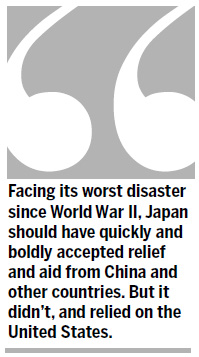Op-Ed Contributors
Turn crisis into opportunity
By Li Wei (China Daily)
Updated: 2011-04-08 08:03
 |
Large Medium Small |

Japan should identify its real problems, learn from wartime lessons, and reform its structures and diplomatic focuses
The question now being asked by many across the world is will Japan see a decline in its national strength or have enough vitality to move forward after being devastated by the earthquake, tsunami and the nuclear power plant crisis.
Let us check out some facts first. The structural problems in Japan's political and economic framework, which began emerging after its economic bubble burst in the late 1980s, have been constraining its further development.
|
||||
Instead, the top priority for both parties has been to hold onto power. Japan's political parties depend more upon campaign tactics and have been caught in the whirlpool of public opinion, which politicians manipulate and also find themselves manipulated by.
There are two factors behind this phenomenon. First, ideological confrontation in Japan has weakened since the Cold War era, and the ruling and opposition parties both tend to be conservative. Second, the small electoral district system in Japan forces political candidates to focus on rallying public opinion.
When Japan was trying to catch up with the West, its development goal was clear and bureaucrats were executing policies at the national level. But after entering the post-industrial era, Japan didn't adjust its development pattern, making the public disappointed with "statesmen" whose only aim seemed to be winning votes.
On the economic front, fiscal deficits and an aging population are two major obstacles on Japan's development road. According to figures from the Finance Ministry of Japan's in December 2010, the country's national debt balance (including bonds, loans and short-term government bonds) was a record 919.15 trillion yen ($11.12 trillion). The record budget of 92.4 trillion yen for the 2011 fiscal year needs new debt sales of 44.3 trillion yen to finance.
Expenditure on social security, which increases by 1 trillion yen a year, is the heaviest burden on state finances. The reduction in Japan's working-age population caused its potential growth rate to drop from 4 percent in the 1980s to 1 percent last year. And if the population structure continues to deteriorate, it will further strain the country's economic growth potential.
Japan's fiscal expenditure and the state finance's debt burden will increase dramatically because of the triple disaster.
Hence, the biggest problem for Japan now is how to raise the much-needed funds. Should it increase taxes, withdraw funds from abroad, or inject more liquidity?
| 分享按钮 |


